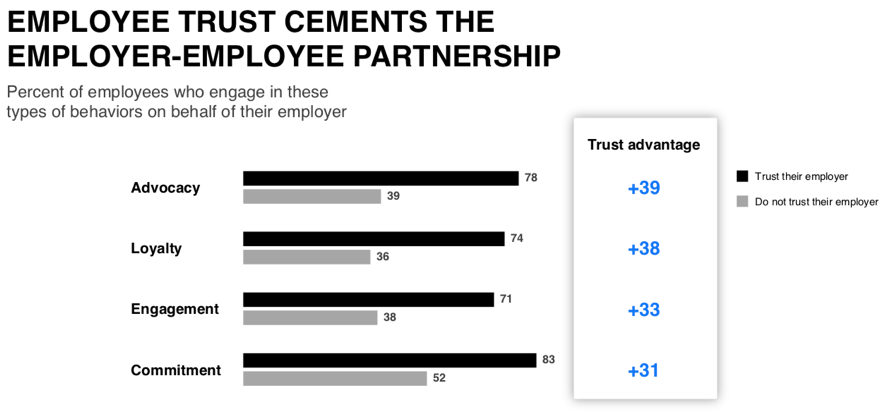The Key to Achieving Your Leadership Objectives: Building Employee Trust

We talk a lot about building trust here at Quantified. As communicators, we’re most successful if we can convince our audiences to trust us. They’re more likely to focus on what we’re saying (rather than sifting through our content in search of ulterior motives), more likely to internalize our key points, and more likely to act on our messages.
We’ve written about trust in the context of media, of politics, and even of corporate activism. But let’s focus now on everyday leadership, on the importance of trust between an executive and her team. What does employee trust enable leaders to achieve, and how do leaders build that trust?
The Leadership Objective: Steering the Ship
Above all, it’s a leader’s job to communicate and execute her vision for her organization. Sometimes (and it can seem like all the time) that means steering the company through change of one kind or another. Maybe market demand has shifted, necessitating the business rethink its offerings; maybe significant growth has led to a restructuring; or maybe new system implementation has frustrated employees or even made them feel their jobs may be on the line.
In times like these, it’s up to the leader to be the visionary, creating a clear picture of the change process and the intended end result, and helping employees understand their roles in the upheaval.
You can learn more about what it takes to be a visionary leader in Quantified CEO Noah Zandan’s TED Talk, but as Edelman reminds us in their 2019 Trust Barometer, before they can expect employees to step up and embrace these visions, leaders have to earn their teams’ trust.
The report found that, when employees trust their employers, they’re significantly more likely to advocate for them and remain loyal, engaged, and committed than when the employer/employee relationship isn’t founded on trust.

Source: 2019 Edelman Trust Barometer, Pg. 32
So what does it take to build the trust that inspires employees to help leaders bring their most far-flung visions to life?
Employee Trust Equals Communication Plus Follow-through
When it comes to building trust, a leader’s number-one tool is her communication strategy. When we measure trustworthy communication, we look at patterns associated with deception, such as negative sentiment and overly complex language, as well as more positive traits like accountability and a level of detail that is cognitively difficult to convey. When we break that down, there are three things we recommend leaders focus on in order to build trust with employees through communication:
1. Making it Personal
When it comes to building trust with employees, keeping your communication personal is critical. This doesn’t mean oversharing or diving into your personal life; it means taking accountability for the choices you’ve made as a leader and clearly articulating what these choices mean for your audience.
We’ve all heard leaders try to shrug off responsibility through passive language. (“Mistakes were made,” anyone?) And it’s understandable why someone would try to step out of the spotlight when things go wrong. But evading accountability like this only serves to erode any trust you’ve built. Instead, focus on first-person pronouns that will show you own your decisions and believe in your actions. When employees see you’re not trying to shy away from change, they won’t, either.
Additionally, make your message personal for employees. If they’re concerned about their job security, don’t be vague. “There will be some restructuring, but jobs will not be in danger” is much less comforting than “Your roles may evolve, but I can assure all of you that your positions with the company are safe.”
2. Offering Details
One key mark of a trustworthy communicator is her ability to offer granular insights as to the hows and whys behind her message, explaining not only what’s happening but what’s not happening as a result. So when you’re sharing your vision or talking employees through a disruption, don’t leave it at “because that’s how it is.” As much as you can, explain why and how you’ve reached the conclusions you’ve reached, and outline what’s likely to happen—and not happen—as a result.
Listeners are more likely to trust speakers who go beyond generalities and support their messages with detailed commentary about the situation at hand. So, while you may not be able to divulge every detail, if you want to build trust with your employees, it’s important to give them as much information as possible.
3. Staying Positive
Finally, research has shown that dishonest communicators tend to be highly negative in the language they use. So, to build trust, we recommend leaders stay positive. This doesn’t mean sugarcoating problems, but it does mean framing your conversations around solutions rather than focusing on catastrophes.
Offering personalized, detailed, positively oriented communication to guide employees through growth and change will work wonders for building trust and inspiring loyalty. However, all the trustworthy communication in the world will start to fall flat if the follow-through doesn’t match the message. So when you’re making promises and outlining plans, be sure you can stick to them. And when you can’t, look back at the first tenant of trustworthy communication: take responsibility for the mistake and explain, in detail, how you plan to rectify it.
As a leader, it’s your job to steer the ship through whatever winds and storms come your way. But without the trust of your team, even the clearest visions will struggle to take hold.